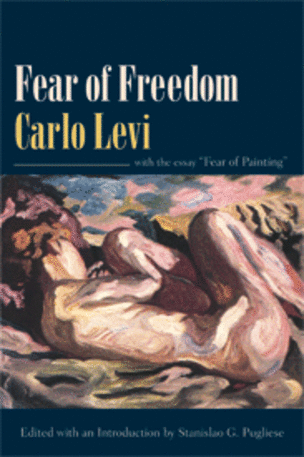


On Monday April 21st, Stanislao G. Pugliese [2]presented his new edition of Carlo Levi's Fear of Freedom [3]at the Italian Academy, Columbia University. [4] This new edition with an introduction by Professor Pugliese is being published by Columbia University Press and features new pieces of Levi's artwork as well as the first English translation of his essay "Fear of Painting" that Levi wrote in 1942, and appeared with the original edition of Fear of Freedom.
Professor Pugliese said in his presentation that this edition had been 20 years in the making, ever since he had read Christ Stopped at Eboli as an undergraduate and that book influenced him so much that he "went to the library to find more things about Carlo Levi and quite by accident I stumbled across the 1950 English translation of Paura della Liberta'."
Fear of Freedom was written by Levi at the eve of World War II while in exile, after having been arrested for being a very active member of the anti-Fascist movement Giustizia e Libertà. It is a product of his observations of what he was seeing as the decline or fall of civilization. In France, he was seeing the mobilization of the German Army and the news of the invasion of Poland. At the same time his father was dying in Turin and Levi was unable to get to him or later attend his funeral. The effect of the situation on his personal life, as well as the broader effects, served as the push for Levi to write Fear of Freedom.
In Fear of Freedom Levi seems to precede the psychologist Eric Fromm in his observations on humanity and religion – always shifting between the sacred and the sacrificial, and the tendency of humans to want to lose oneself in the masses and the resulting loss of creativity and individuality.
The book, written in 1939 was eventually published for the first time in 1946 – Levi insisted that his essay "Fear of Painting" be appended as a kind of epilogue to the book. Fear of Freedom was printed for the first time in English in 1950 and that translation is republished in this new edition. "When I first thought of doing this edition I tried my hand at translating it but I could not do better than this," said Pugliese.
Levi makes numerous literary and biblical references in Fear of Freedom and it was surprising to learn that they were all from memory as he no longer had access to his extensive library.
The book, which precedes what is probably Levi's most famous work, Christ Stopped at Eboli, is a meditation on human morality and spirituality in a moment when Europe was in tremendous turmoil. What emerges and what was the center of the discussion at the presentation is humanity's "Eternal tendency towards fascism."
"Reading the books side by side," continued Prof. Pugliese, "I was shocked by how incredibly different they were, even though written by the same author, not that many years apart, but they were really two extraordinary works".
Prof. Pugliese wanted to include the essay "Fear of Painting" because of Carlo Levi's strong belief that "painting was a form of anti-fascism. To be a great painter in the 20s and 30s Levi believed you could only be anti-fascist." Levi also used his painting studio as a cover for inviting over friends to discuss the political situation.
Professor Pugliese was joined by Alexander Stille, [5] San Paolo Professor of International Journalism at Columbia and author on multiple books about Italy, and Peter Carravetta, Alfonse M. D'Amato Professor of Italian and Italian American Studies at Stony Brook University, for a discussion on this new edition as well as a more general discussion on Fascism and the relevance of Carlo Levi's book today.
In discussing the text Professor Stille described Levi's book as a "brooding dark meditation of society at the brink of the apocalypse". He also commented that the text veered off into poetic language and that it resisted linear interpretation and suggested that Levi's book should be read as a poetic text, allowing the reader to "go with it, surfing along without being sure of what it means but enjoying the ride."
Professor Carravetta, after an analysis of the translation of the text, said that the book should be read as a combination of, "an aphorism, which is a fragment of a tragedy, and an essay, which is a fragment of an analysis."
Source URL: http://test.iitaly.org/magazine/focus/facts-stories/article/stanislao-puglieses-edition-fear-freedom-levis-book-poetic-text
Links
[1] http://test.iitaly.org/files/fear1209614505gif
[2] http://people.hofstra.edu/stanislao_pugliese/main.htm
[3] http://cup.columbia.edu/book/978-0-231-13996-0/fear-of-freedom
[4] http://www.italianacademy.columbia.edu/news/news_main.htm
[5] http://www.journalism.columbia.edu/cs/ContentServer/jrn/1165270051276/JRN_Profile_C/1165270081339/JRNFacultyDetail.htm